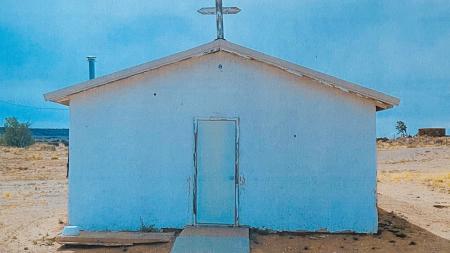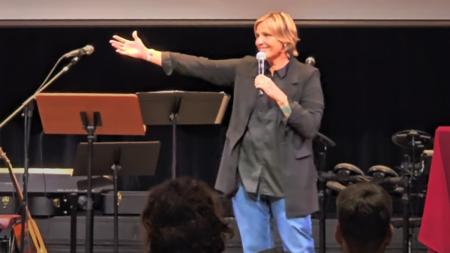Grant Makes Way for ‘Sacred Play’

Mimi Larson, assistant professor of educational ministries at Trinity Evangelical Divinity School in Deerfield, Ill., will be coordinating a Vital Worship grant on the topic of sacred play, received from the Calvin Institute of Christian Worship (CICW).
A children’s ministry catalyzer for the Christian Reformed Church’s Faith Formation Ministries, Larson will be working with five congregations, including one in the CRC, to find ways to incorporate play on the part of children into worship.
“The grant will help us to explore children’s play and weave it into worship contexts,” said Larson, one of the editors of Bridging Theory and Practice in Children's Spirituality. “This is out-of-the-box thinking that some churches have considered as frivolous – but play on the part of children is really a gift we can give to the church.”
“Mainly, the grant will help congregations consider how they can shape their offerings to children by using play in helping them learn more about beliefs, practices, and liturgical activities of the church,” she said.
This is not a program, Larson added – “just as preaching to adults is communication and not a program.”
“As advocates for children, we are intentional that ministry with children (especially our endeavors with sacred play) is more than a program to children. Children are equal imagebearers in our faith communities, and our nurturing of their faith is more than a program,” she said. “It is a sacred activity.”
“I'm excited that Mimi and her team of children's ministry leaders have received this grant from CICW,” said Chris Schoon, director of Faith Formation Ministries.
“There is so much opportunity,” he added, “to learn about how faith is formed among younger imagebearers, especially with regard to how play can contribute to a healthy approach to their discipleship. I anticipate that the whole church will benefit from this attention to children and how they make meaning.”
Through sacred-play opportunities, Schoon said, “children can also be introduced to faith practices that will shape their attentiveness to the Holy Spirit, their formation in Jesus Christ, and their love for God and their neighbors. And it’s exciting to see this type of care and intentionality with nurturing a lifelong faith in children.”
CICW recently announced that it has awarded 25 Vital Worship Grants projects to worshiping communities, including Larsons’s cohort, for 2022-23 as part of its Vital Worship Grants Program. This year’s grants, CICW has now awarded over 1,000 grants through this program.
Creston CRC in Grand Rapids, Mich., received a Vital Worship grant this year to gauge the effect that acts of hospitality – such as neighborhood meals – can have on the quality of life and worship in its church.
Kathy Smith, leader of the Vital Worship grants team, said CICW is “grateful to award these new grants, trusting that these projects will serve to encourage vital worship in new ways and support yet another group of churches, schools, and organizations, even in these difficult times.”
These grant projects have a variety of emphases, Smith added, many of which have been shaped by nearly two years of adapting ministry during a pandemic.
In addition to projects that engage Scripture, focus on music and singing, and promote practices of hospitality in and through worship, some especially creative projects include “partnering the creation of pottery in worship with imagery of God as a potter, and developing a worship space in a rural ministry center,” said Smith.
These projects all have as a common purpose a desire to both deepen people’s understanding of worship and strengthen practices of public worship and faith formation, she said.
“This year’s recipients include 15 congregations, three seminaries, two universities, one grade school, and four other ministries including a rural retreat center, two denominational organizations, and an environmental education institute. They also represent 13 different Christian denominations in addition to some interdenominational and ecumenical projects,” and the various recipients are located in 16 states.
John Witvliet, director of CICW, said, “We are eager to learn from these programs. These projects developed in the midst of the COVID-19 pandemic have emerged from resourceful teams of local leaders responding to pressing needs and opportunities in their contexts. We look forward to sharing learning from these creative efforts over the next several months and years.”
Smith said she is eager to see the work on sacred play that will be done in the coming months.
“I’m intrigued by Mimi’s project. . . . We're especially grateful that Mimi will be working with several congregations from different Christian traditions over the next year, giving the project a rich ecumenical approach to learning and enhancing the worship experience for children and congregations.”
Larson, who also received a CICW Teacher-Scholar Worship grant in 2020, said her current effort of looking at sacred play will be more than about young people simply playing church for fun as part of a children’s program.
This is about “having a playful and respectful attitude toward worship” and developing practices that, perhaps down the road, everyone in a church can take part in, said Larson.
Larson helped Covenant CRC in Edmonton, Alta., develop a program of sacred play and points to it as an example of what churches can do.
“This can be a challenging process in making changes,” she said. “You want to make sure everyone is all together and on board with this.”
In a blog post on the CRC's Network, Jennifer Uitvlugt, director of Family Ministries at Covenant CRC, describes some of the changes that began at her congregation after she received an important insight.
She writes: “Our church was in the midst of giving our nursery a fresh, new look, and as this project took off, we found ourselves wrestling with ideas of what to include for dramatic play. After visiting a kindergarten classroom and watching the children play ‘house,’ it dawned on me that kids mimic adults in everything they do. We have play kitchens, tool benches, vacuums, and fishing rods. This is how kids learn about the world around them. All of a sudden, I could just imagine how kids could play ‘church’ and experience church in a tactile environment!”
Play churches have already been created in some European churches, such as in the Diocese of Edinburgh, Scotland; in Linköping (Sweden) Cathedral; and in Malmö, Sweden (St. Catherine’s Play Church).
Eventually, Covenant CRC drew up plans and put together a team to build their own version of a play church.
“We completed the project and set it up in November 2021. Children have been given everything they need to play at church; equipment includes a kid-sized pulpit, baptismal font, communion table, pew, and piano,” Uitvlugt writes.
Throughout the process, she said, they have been careful in developing the items used and how they ought to be used in helping to guide children in the worship of God.
“Accessories that children can play with inside are a Bible, a hymnbook, a baby in a baptismal gown, a pitcher, wine cups, grapes and bread, a microphone, and seasonal play items like an Advent wreath and Lent manipulatives,” Uitvlugt writes. “There are even ‘stained glass’ windows and color changes for the liturgical cloth on the cross.”
Too often, said Larson, churches tend to shuffle the children off into programs just to keep them busy. But using creative ways to cultivate children’s spirituality are important, especially as they learn about the church they can become part of as adults.
“Sacred play is a primary way in which we can help pass on our faith to our children,” said Larson.


